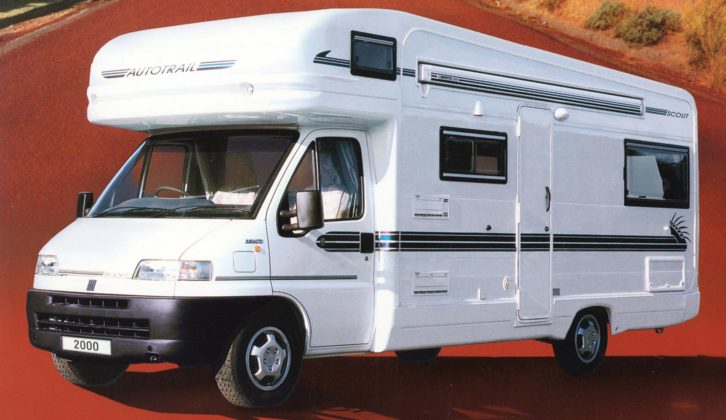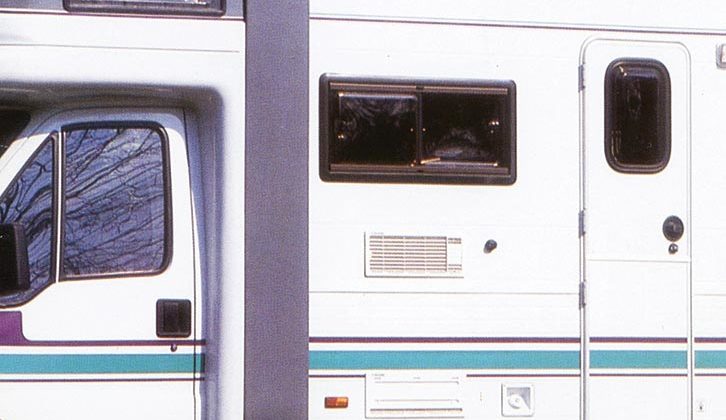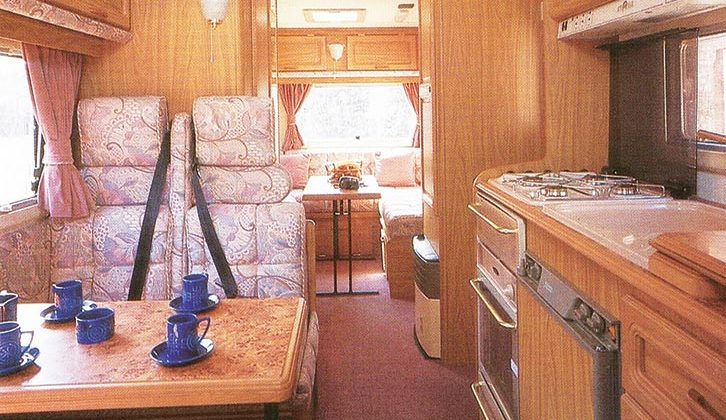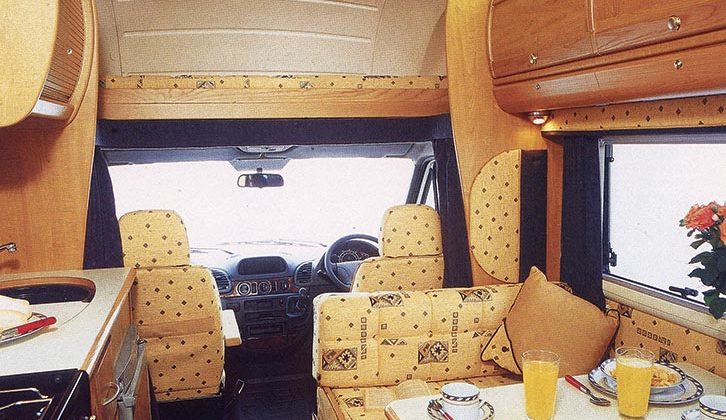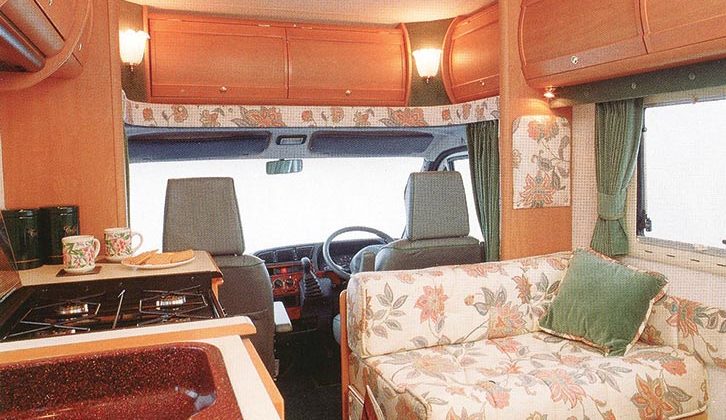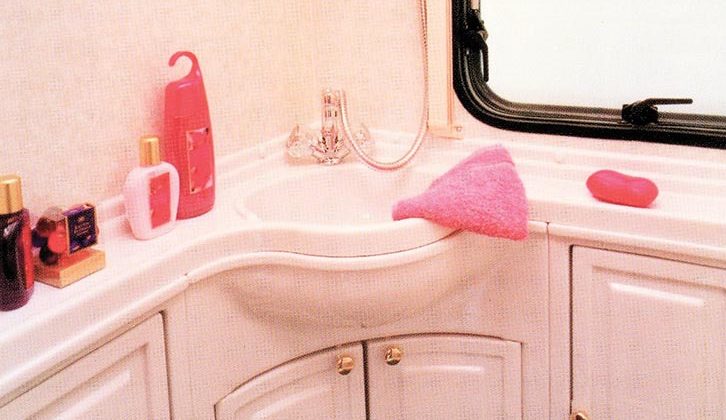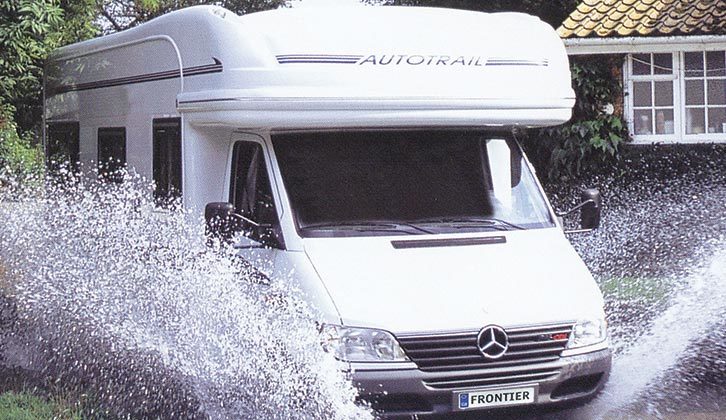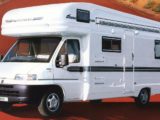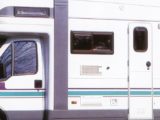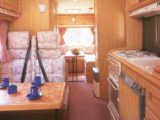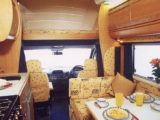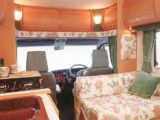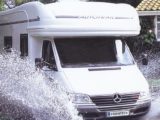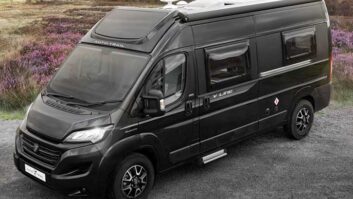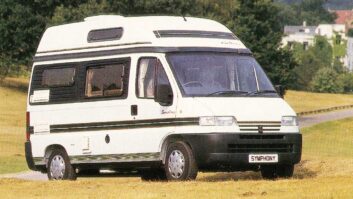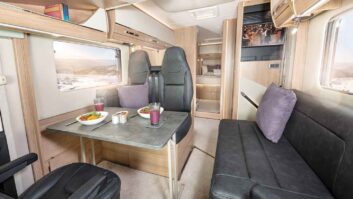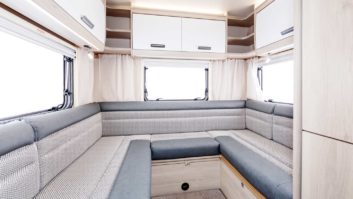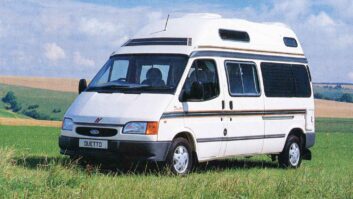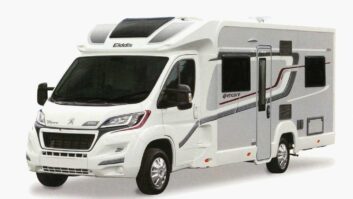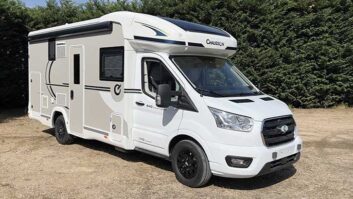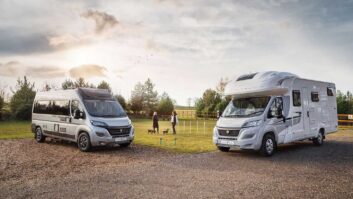The old adage, ‘If it ain’t broke, don’t fix it’, most definitely applies to the Auto-Trail Scout. From its inception to the present day, the layout has remained the same, with continued strong sales proving just how right it was from the off.
The Scout’s interior is sometimes described as a ‘three-room’ motorhome layout, and it’s easy to see why.
Room one is the kitchen-diner (forward nearside kitchen with double Pullman dinette opposite). Room two is the central washroom with walk-in shower compartment, and room three is the U-shaped rear lounge.
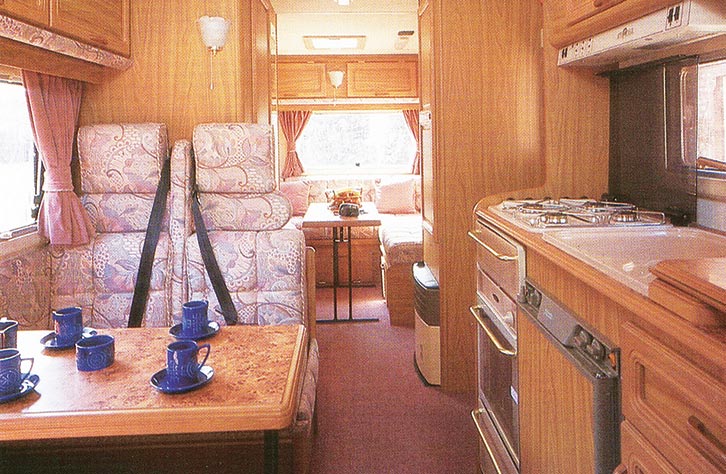
The sleeping accommodation consists of a high-level transverse double in the Luton, a longitudinal double converted from the Pullman dinette, and a choice of two singles or an ‘all-over’ double converted from the rear lounge.
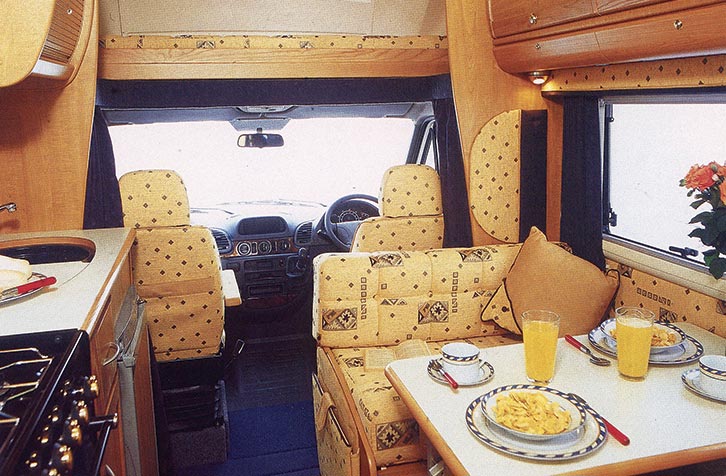
Standard number of travel seats was four including the driver, although six could be specified as a cost-option.
The Scout was launched 32 years ago on the facelifted Talbot Express Al-Ko with a 2.0-litre petrol engine as standard. It transferred to the X/44 Ducato at the base vehicle’s launch in 1995.
Overall length was 6.84m (22’ 5.25”), with diesel or turbodiesel engine, and a cutting-edge fascia-mounted gearlever.
American Cherry was the chosen furniture finish, and the standard spec included dual-fuel space and water heating, a full (enamel) domestic-style cooker and rear corner steadies.
The following year brought a new roofline, plus the use of grey skirts and (controversially) grey highlighting to an upright column just behind the cab. It also grew to 7.09m (23’ 3.25”).
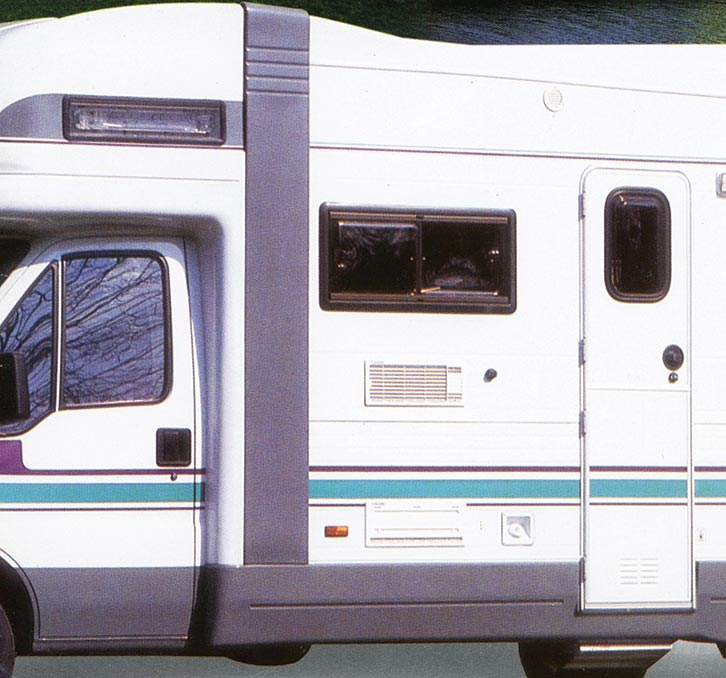
For 1997, the grey skirts and upright reverted to white, and the Scout was – for the first time – also offered on the Mercedes-Benz Sprinter and the five-cylinder TD Volkswagen LT.
Newly available as a no-cost option was a low-line overcab, replacing the double bed with additional high-level lockers. Increases in base vehicle prices resulted in the Ducato TD version breaking through the £40,000 price barrier. Folk said they wouldn’t sell at this price, but of course they did… and in considerable numbers!
A one-piece glazed entrance door replaced the ‘stable’ type in 1998. Further improvements in a major facelift included a one-piece moulded GRP roof, a redesigned back panel with spare wheel storage, and a recessed awning. Inside, the change was made to curved locker doors and updated cabinetwork, while underneath, the Maxi chassis provided a much-needed increase in available payload.
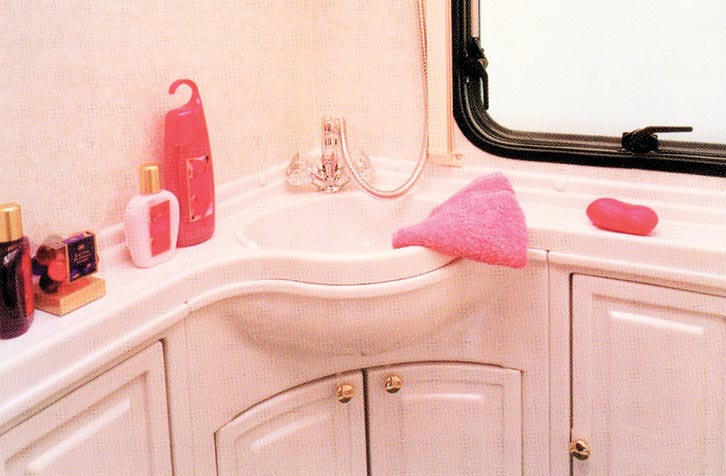
Finally, it grew yet again – on the Ducato base, to 7.29m (23’ 11”) and on the Merc/VW, to 7.34m (24’ 1”).
In 1999, Fiat upgraded its turbodiesel engine to a direct-injection 2.8-litre unit. The year after, Mercedes-Benz launched the Euro-Sprinter with warp-factor improved handling and the option of Sprintshift – a robotised manual gearbox offering a two-pedal drive. Then 2003 saw a change to the upright spare wheel storage with a restyled cover, plus the launch of the SE pack, offering a raft of goodies for very little additional dosh.
Finally, for 2005/6 run-out models, buyers could opt for Eberspächer’s diesel-fired heating… provided they crossed some palms with sufficient silver! That said, improved white goods, a brace of leisure batteries and upgraded domestic electrics arrived with no rise in the RRP, although there was a small increase in overall length.
The Scout subsequently transferred to the next two generations of Ducato and today, remains an integral part of Auto-Trail’s flagship Frontier range.
What to look out for in an Auto-Trail Scout
Base vehicle
Ducato is by far the most popular choice, and with good reason: it’s very stable on the road and an engaging drive. However, earlier models on the 3400/3500kg chassis had limited payload, although chassis upgrades remain available. Group C1 driving licence is required for an upgraded standard chassis or Maxi version.
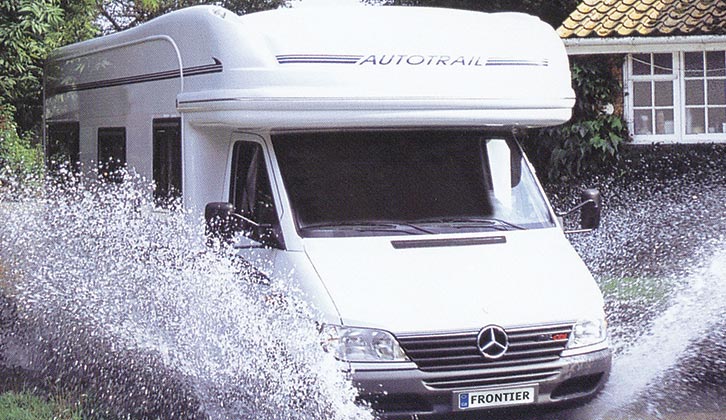
Mercedes’ Sprinter was the second most popular, but pre-Euro-Sprinters were very softly sprung, resulting in a rather ‘roly-poly’ ride. VW’s LT had a silky-smooth five-cylinder turbodiesel engine, offering a magic-carpet drive.
Early VW LT models can suffer from premature steering rack failure and some (including the author’s own) chewed through expensive brake discs and pads with amazing rapidity. Check for any vagueness on the steering and clattering coming from the front end over potholes/cobbles.
Conversion
As with any coachbuilt, insist on a full damp inspection with a written report, and check yourself for any musty smells or stained trim. Examine the report on the most recent habitation service. Keep some money in reserve for new smoke and carbon monoxide alarms, plus for a new fire extinguisher and fire blanket. Ensure that the seat-to-bed conversions and the blinds/flyscreens are all working smoothly.
Take a look at our guide to the used motorhome interior checks you should carry out for further insight into what to look out for.
Our Auto-Trail Scout pick
Manual transmission: Direct-injection Ducato Maxi-based examples. If you’re looking for an automatic, a Mercedes Sprintshift underpinned one is your only option. Sprintshift was criticised at the time, but has proved itself to be ultra-reliable, if not quite as smooth as a torque-converter automatic.
Or you could try…
If you’re interested in a more modern Auto-Trail ‘van, why not take a look at our review of the Auto-Trail F68? It’s a ‘van that is ideal for couples, and also won the best 2 berth motorhome at the Practical Motorhome Awards 2022.
Alternatively, you could try:
- Swift Kon-Tiki 640
- Elddis Autostratus EB
- Cheaper Auto-Trail with similar layout: Apache 700.
Our guide to the best used motorhomes is also full of great models to consider, if you’re looking for some further pre-owned vehicle inspiration.
Essentials
- Auto-Trail Scout on Fiat Ducato/ Mercedes-Benz Sprinter/VW LT chassis-cab
- Built 1995-2006 in Immingham and later in Europarc, Grimsby, North Lincolnshire
- Luton and low-profile overcab coachbuilts
- Overall length, 2006 model: 7.39m (24’ 3”)
What we like
- Three-room layout
- Family-friendly
- Auto-Trail’s stylish furniture and fabrics
- High standard spec
What we don’t like
- No automatic transmission on RHD Ducato or VW LT
- Limited payload on 3400kg examples
What to pay
Private sales are available from £14,995 (1995 Ducato), and trade sales from £20,000.
If you’ve enjoyed reading this article, why not get the latest news, reviews and features delivered direct to your door or inbox every month. Take advantage of our brilliant Practical Motorhome magazine SUBSCRIBERS’ OFFER and SIGN UP TO OUR NEWSLETTER for regular weekly updates on all things motorhome related.
